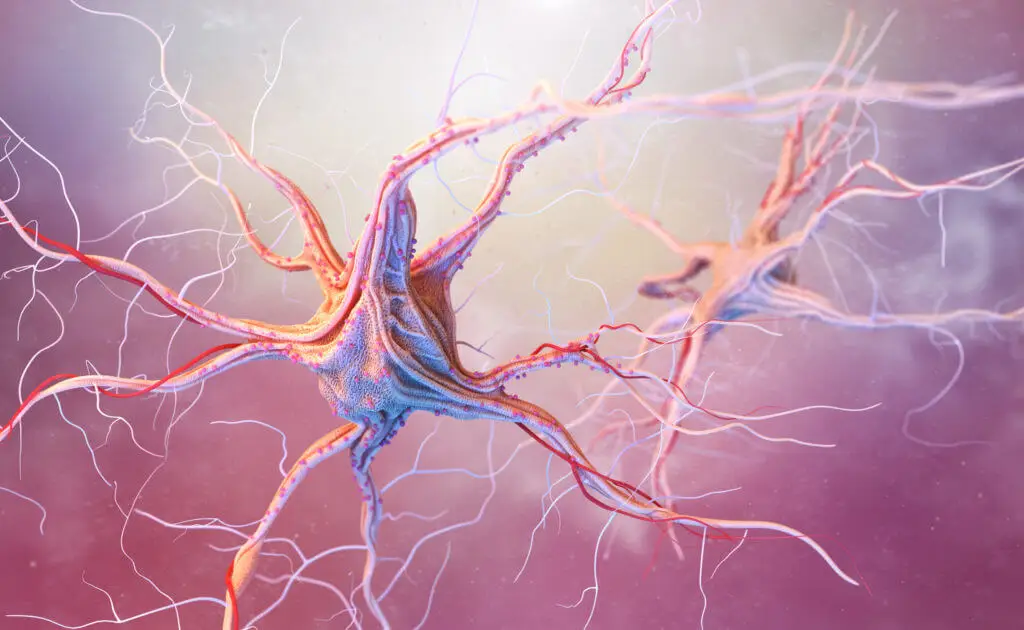“I never knew how hard it could be to button a shirt without feeling my fingers.”
As I work with patients experiencing nerve damage, conversations often turn in this direction. Our bodies are incredibly complex, and yet most of the time they function very well.
It is easy to take this for granted. After all, we don’t retain our infant memories of the neurological boot camp where we toddled and fell for years before learning to run, jump, swim and type.
But when systems fail, we suddenly realize what miracles had been occurring all the time.
In this article, I hope to draw back the curtain on a few of the miracles of the human nervous system—the way we interact with our whole world—and share with you the sense of marvel that I hope I will never have to sustain nerve damage to appreciate!
The Longest Nerve
We typically think of cells as microscopic squares or ovals like you might have seen on a glass plate in High School biology class, but despite their tiny cross-section, some cells like muscles and nerves can be extremely long!
The longest nerves in the human body travel from sensory receptors in the big toe all the way up the back of the leg through the sciatic nerve, into the spinal column through the cauda equina, and finally, end with spinal cord synapses in the upper lumbar region.
For Robert Wadlow, the tallest man in recorded history, this means that a nerve fiber 150 times thinner than a strand of hair would be 6 feet 5 inches (196 cm) long or more. If we scale up this nerve to the thickness of an overhead power line, it would stretch 250 miles—a little wider than the state of Missouri!
Naturally, it can be difficult for such a thin nerve to transport nutrients from end to end, making very tall people more likely to experience numbness and tingling in their hands and feet from undernourished nerves.
The Sixth Sense
Everyone has heard of the five senses: Sight, hearing, touch, taste, and smell, and according to a popular movie the sixth sense is apparently the ability to see ghosts, but the number of other senses you have would surprise even Bruce Willis!
Here are a few samples from the list of superpowers you may not have known you possess:
Vestibular sense: Your inner ear (the vestibular system) is responsible for tracking which way is up and whether the body is accelerating or spinning in any direction. This is what causes the jolt you feel when someone slams on the car breaks, as well as the sensation of falling which makes you reach out to catch yourself. Anyone who has experienced vertigo will know how unpleasant it can be when your positional senses malfunction, but on the other hand theme parks make their money by manipulating the vestibular system for fun!
Proprioception and Kinesthesia: The inner ear may tell how the body is moving as a whole, but you also have an army of stretch receptors around your joints and muscles which keep track of what angle your joints are at (this ability is called proprioception) and what direction they are moving (AKA kinesthesia). It’s easy to take this for granted, but can you imagine a world where you didn’t know what your arms and legs were doing when you weren’t watching them? For some people, this is a reality. When proprioception malfunctions people cannot walk in the dark or move a spoon to their mouth without carefully watching their limbs to be sure they are in the right place.
Temperature and Pain: Some senses, like proprioception, need to travel to the brain as fast as possible so you can have a real-time concept of where you are. Others, like pain and temperature, are not quite as high priority and travel to the brain through different nerve fibers that are a little slower because they lack an insulating coating called myelin. This is why you may touch something for a moment or two before you realize how hot it is! There are some types of neuropathy which preferentially damage these myelin-free nerve fibers. When these nerves malfunction, a person may feel burning and pain all the time or might not be able to feel pain at all, which can be very dangerous.
Stereognosis: Our nerves send around 11 million bits of information to the brain every second, and our brains are able to blend the sensory superpowers into incredible combinations. Stereognosis is the ability to hold an object and tell what it is without looking. Consider how amazing that is! Touch receptors outline the object, pressure receptors in the skin and stretch sensors in the muscles tell how heavy it is, proprioceptors give an idea of scale, while temperature receptors and pain receptors tell what it’s made of and if it’s dangerous. In a split second, you can tell the difference between grabbing a key or a scorpion!
Nerves with a Mind of Their Own
The processing power of the brain is truly unrivaled, but did you know that many body functions can be controlled by the rest of the nerves without consulting the brain?
You may already be more familiar with this concept than you know. The last time you got a check-up, chances are that your physician tapped your knee with a tiny hammer and before you knew it your foot had bounced up in the air. This is because of a very simple reflex: Nerve endings in your patellar tendon send the message to the spinal cord that the tendon has been unexpectedly stretched, and a motor signal is automatically deployed to correct the problem by contracting your muscle, all without consulting your brain on the matter.
Your movement system is full of little reflexes like this. For example, reciprocal inhibition is where activating muscles that move your joints in one direction (i.e. bending your knee) automatically deactivates muscles that would do the opposite (i.e. straighten the knee).
Musculoskeletal nerves aren’t the only ones with a mind of their own. The gut has a set of nerve connections (the enteric nervous system) so complex that it has been termed the “second brain.” For example, when stretch receptors in your stomach detect that you’ve started eating, signals go out to all portions of your gastrointestinal system to move out the old food and make room for the new. This is why people often feel the need to use the restroom a few minutes after starting a meal.
Neuroplasticity
There is a myth that damaged nerves can never heal, but in fact, one of the most incredible aspects of our nervous system is that it is constantly changing and adapting to the demands we put on it through a process called neuroplasticity.
For example, the ends of each motor nerve (nerves carrying signals to the muscles) are constantly sprouting branches, looking for any lonely muscles without innervation, and incorporating them into the motor unit.
Because of this, when some motor nerve cells are damaged beyond repair (such as in a person with polio), the remaining nerves will organize a search and rescue effort to find and adopt the orphaned muscle fibers, resulting in the patient regaining some strength and function.
A surgeon can even transfer an intact nerve from an unimportant muscle to a more critical muscle that has lost its nerve supply, and the brain will soon rewire to control the new muscle/nerve alliance naturally!
Speaking of the brain, it is the home of the most incredible examples of neuroplasticity ever seen.
You may have heard that little children are built to learn, but even as adults our brains are amazingly adaptable.
In laboratory experiments, monkeys have been trained to precisely control robotic arms using only their minds, with brainwaves recorded and relayed to the prosthetic. Over a series of weeks, their brains learn to accept and manipulate a whole fifth limb that they were not even born with!
In humans, blind individuals can be benefited by new devices which relay images from a glasses-mounted camera to an “electrode lollipop” placed on the tongue. The electrodes stimulate taste buds in response to what the camera sees, and soon the amazing brain starts to realize, “this isn’t taste…this seems more like sight!” The taste signals are then rerouted to the optic center in the occipital lobe, and the person can begin to “see” with his or her tongue!
Summary
Nerves truly are amazing things. They carry information incredibly fast from one end of the body to the other and they are so adaptable that they can do everything from making a roller coaster fun to psychically controlling technology.
Your nervous system is as important as it is powerful, and it is important to treat it well. So if you have noticed any numbness, weakness, or other symptoms which indicate a nerve disorder, talk to your physician about it. In most cases, nerves can heal, and with the right treatment, you can get the miracles of movement, sensation, and function back in your life.

EMG Solutions



